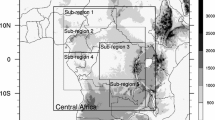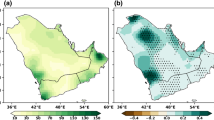Abstract
One of the most important areas of current research is the impacts of climate change on climatic parameters, especially temperature and rainfall, as those have direct linkages with vegetation, agriculture and livelihood of people. This study attempts to analyse the possible future climatic changes in a semi-arid area, taking as an example Essaouira basin located on the Atlantic coast of Morocco. The present precipitation and temperature patterns and expected future changes (2018–2050) in Essaouira basin are investigated using the Canadian Earth System Model (CanESM2) of the IPCC Fifth Assessment Report and reanalysis from the National Center for Environmental Prediction (NCEP) under the fifth phase of the Coupled Model Intercomparison Project (CMIP5) protocols for historical and future emission scenarios simulations. Statistical downscaling model (SDSM) is used for the downscaling. Non-parametric Man-Kendall and Pettitt’s tests are used to determine the trend and change point of temperature and precipitation series, respectively. The combined application of the results of SDSM, and the non-parametric trend and change point tests in the study area, for the study period 2018–2050, showed a downward trend of annual rainfall for Representative Concentration Pathway (RCP) 4.5 (17.29%) and upward trends for RCP 2.6 and RCP 8.5 (12.50% and 21.33%, respectively). The annual mean temperature was found to increase by 0.72 °C, 0.57 °C and 0.69 °C under the RCP 2.6, 4.5 and 8.5, respectively. Furthermore, the study area is predicted to have a shortening of the wet season from five (November to March) to four months (December to March).





Similar content being viewed by others
References
Ait Brahim Y, El Mehdi SM, Kouraiss K, Sifeddine A, Bouchaoua L (2017) Analysis of observed climate trends and high resolution scenarios for the 21st century in Morocco. JMES 8(4):1375–1384
Assani AA (1999) Analyse de la variabilité temporelle des précipitations (1916-1996) à Lubumbashi (Congo-Kinshasa) en relation avec certains indicateurs de la circulation atmosphérique (oscillation australe) et océanique (El Niño/La Niña). Sécheresse 10(4):245–252
Babqiqi A (2014) Changements Climatiques au Maroc: Etude du cas de la Région de Marrakech Tensift Al Haouz et implications sur l'agriculture à l'horizon 2030. Thèse de doctorat, Université cadi Ayyad
Chen H, Xu CY, Guo S (2012) Comparison and evaluation of multiple GCMs, statistical downscaling and hydrological models in the study of climate change impacts on runoff. J Hydrol 434-435:36–45
Dorji S, Herath S, Mishra BK (2017) Future climate of Colombo downscaled with SDSM-neural network. Climate 5(1)24:1–11. https://doi.org/10.3390/cli5010024
Driouech F (2010) Distribution des précipitations hivernales sur le Maroc dans cadre d’un changement climatique: descente d’échelle et incertitudes. Thèse de doctorat, Université de Toulouse
Feng S, Hu Q, Huang W, Ho CH, Li R, Tang Z (2014) Projected climate regime shift under future global warming from multi-model, multi-scenario CMIP5 simulations. Glob Planet Chang 112:41–52
Fiseha BM, Melesse AM, Romano E, Volpi E, Fiori A (2012) Statistical downscaling of precipitation and temperature for the upper Tiber Basin in Central Italy. Int J Water Sci 1(3):1–14
Fowler HJ, Blenkinsop S, Tebaldi C (2007) Linking climate change modelling to impacts studies: recent advances in downscaling techniques for hydrological modelling. Int J Climatol 27(12):1547–1578. https://doi.org/10.1002/Joc.1556
Gagnon S, Singh B, Rousselle J, Roy L (2005) An application of the statistical downscaling model (SDSM) to simulate climatic data for streamflow modelling in Québec. Can Water Res J 30(4):297–314
Gebremeskel S, Liu YB, Smedt F, Hoffmann L, Pfister L (2005) Analysing the effect of climate changes on streamflow using statistically downscaled GCM scenarios. Int J River Basin Manag 2(4):271–280. https://doi.org/10.1080/15715124.2004.9635237
Gibelin AL, Déqué M (2003) Anthropogenic climate change over the Mediterranean region simulated by a global variable resolution model. Clim Dyn 20:327–339
Hay LE, Wilby RL, Leavesley GH (2000) A comparison of delta change and downscaled GCM scenarios for three mountainous basins in the United States. J Am Water Resour Assoc 36(2):387–397. https://doi.org/10.1111/j.1752-1688.2000.tb04276.x
Herrera E, Ouarda TBMJ, Bobée B (2006) Méthodes de désagrégation appliquées aux Modèles du Climat Global Atmosphère Océan (MCGAO). RSE 19(4):297–312. https://doi.org/10.7202/014417ar
Huang J, Zhang J, Zhang Z, Xu C, Wang B, Yao J (2011) Estimation of future precipitation change in the Yangtze River basin by using statistical downscaling method. Stoch Env Res Risk A 25(6):781–792. https://doi.org/10.1007/s00477-010-0441-9
Hughes JP, Guttorp P, Charles SP (1999) A non-homogenous hidden Markov model for precipitation occurrence. Appl Stat 48:15–30. https://doi.org/10.1111/1467-9876.00136
IPCC (2007a) Climate change 2007: the physical science basis. In: Solomon S, Qin D, Manning M, Chen Z, Marquis M, Averyt KB, Tignor M, Miller HL (eds) Contribution of working group I to the fourth assessment report of the intergovernmental panel on climate change. Cambridge University Press, Cambridge
IPCC (2007b) Climate change 2007: impacts, adaptation and vulnerability. In: Parry ML, Canziani OF, Palutikof JP, Hanson CE, van der Linden PJ (eds) Contribution of working group II to the fourth assessment report of the intergovernmental panel on climate change. Cambridge University Press, Cambridge
IPCC (2013) Climate change 2013: the physical science basis. In: Stocker TF, Qin D, Plattner G-K, Tignor M, Allen SK, Boschung J, Nauels A, Xia Y, Bex V, Midgley PM (eds) Contribution of working group I to the fifth assessment report of the intergovernmental panel on climate change. Cambridge University Press, Cambridge
Kannan S, Ghosh S (2011) Prediction of daily rainfall state in a river basin using statistical downscaling from GCM output. Stoch Env Res Risk A 25(4):457–474. https://doi.org/10.1007/s00477-010-0415-y
Kendall MG (1975) Multivariate nonparametric tests for trend in water quality. Water Resour Bull 24(3):505–512
King LM, Irwin S, Sarwar R, McLeod AIA, Simonovic SP (2012) The effects of climate change on extreme precipitation events in the upper Thames River basin: a comparison of downscaling approaches. Can Water Res J 37:253–274
Knutson TR, Sirutis JJ, Vecchi GA, Garner S, Zhao M, Kim HS, Bender M, Tuleya RE, Held IM, Villarini G (2013) Dynamical downscaling projections of twenty first century Atlantic hurricane activity: CMIP3 and CMIP5 model-based scenarios. J Clim 26:6591–6617
Leung LR, Mearns LO, Giorgi F, Wilby RL (2003) Regional climate research: needs and opportunities. Bull Am Meteorol Soc 82:89–95
Mann HB (1945) Nonparametric tests against trend. Econometrical 13:245–259
Nicholson SE (1986) The spatial coherence of African rainfall anomalies: inter hemispherictele connections. J Appl Meteorol Climatol 25(10):1365–1381
Nigatu ZM (2013) Hydrological impacts of climate change on Lake tana‘s water balance. Thesis, University of Twente
Ouhamdouch S, Bahir M, Carreira P, Chkir N, Goumih A, Chamchati H (2016) Climate change impact on aquifer system of Essaouira basin during the past 4 decades (Morocco). OJMH 6:19–33. https://doi.org/10.4236/ojmh.2016.61003
Parvaze S, Parvaze S, Haroon S, Khurshid N, Khan JN, Ahmad L (2016) Projected change in climate under A2 scenario in dal Lake catchment area of Srinagar City in Jammu and Kashmir. Curr World Environ 11(2):429–438
Pettitt AN (1979) A non-parametric approach to the change-point problem. Appl Stat 28(2):126–135
Rashid M, Mukand SB (2012) Evaluation of SDSM developed by annual and monthly sub-models for downscaling temperature and precipitation in the Jhelum basin, Pakistan and India. Theor Appl Climatol 113(1):27–44. https://doi.org/10.1007/s00704-012-0765-0
Rashid MM, Beecham S, Chowdhury RK (2015) Statistical downscaling of CMIP5 outputs for projecting future changes in rainfall in the Onkaparinga catchment. Sci Total Environ 530-531:171–182
Riahi K, Rao S, Krey V, Cho C, Chirkov V, Fischer G, Kindermann G, Nakicenovic N, Rafaj P (2011) RCP 8.5-A scenario of comparatively high greenhouse gas emissions. Clim Chang 109(1):33–57
Rifai N, Khattabi A, Rhazi L (2014) Impact du changement climatique sur les températures journalières minimales et maximales et les précipitations de la région de Tanger (nord-ouest du Maroc) quantifié à partir d’une méthode de descente d’échelle statistique. VertigO 14(3):1–16
Sachindra D, Huang F, Barton A, Perera B (2014) Statistical downscaling of general circulation model outputs to precipitation-part 2: bias-correction and future projections. Int J Climatol 34:3282–3303. https://doi.org/10.1002/joc.3915
Suh M-S, Oh S-G, Lee Y-S, Ahn J-B, Cha D-H, Lee D-K, Hong S-Y, Min S-K, Park S-C, Kang H-S (2016) Projections of high resolution climate changes for South Korea using multiple-regional climate models based on four RCP scenarios. Part 1: surface air temperature. Asia-Pac J Atmos Sci 52(2):151–169. https://doi.org/10.1007/s13143-016-0017-9
Sunyer MA, Madsen H, Ang PH (2012) A comparison of different regional climate models and statistical downscaling methods for extreme rainfall estimation under climate change. Atmos Res 103:119–128. https://doi.org/10.1016/j.atmosres.2011.06.011
Thomson AM, Calvin KV, Smith SJ, Kyle GP, Volke A, Patel P, Delgado-Arias S, Bond-Lamberty B, Wise MA, Clarke LE, Edmonds JA (2011) RCP4.5: A pathway for stabilization of radiative forcing by 2100. Clim Chang 109(1):77–94
Von Storch H (1999) On the use of ‘inflation’ in statistical downscaling. J Clim 12(12):3505–3506
Wang J, Zhang X (2008) Downscaling and projection of winter extreme daily precipitation over North America. J Clim 21(5):923–937. https://doi.org/10.1175/2007jcli1671.1
Wang Y, Leung LR, McGregor JL, Lee DK, Wang WC, Ding Y, Kimura F (2004) Regional climate modeling: progress, challenges and prospects. J Meteorol Soc Jpn 82:1599–1628
Wayne GP (2013) The Beginner’s guide to representative concentration pathways. Skeptical Science. https://skepticalscience.com/rcp.php. Accessed 25 Aug 2017
Wetterhall FA, Bárdossy D, Chen SH, Xu CY (2006) Daily precipitation-downscaling techniques in three Chinese regions. Water Resour Res 42:W11423. https://doi.org/10.1029/2005WR004573
Wetterhall FA, Bárdossy D, Chen SH, Halldin S, Xu CY (2009) Statistical downscaling of daily precipitation over Sweden using GCM output. Theor Appl Climatol 96(1):95–103. https://doi.org/10.1007/s00704-008-0038-0
White CJ, McInnes KL, Cechet RP, Stuart SP, Grose MR, Holz GK, Katzfey JJ, Bindoff NL (2013) On regional dynamical downscaling for the assessment and projection of temperature and precipitation extremes across Tasmania, Australia. Clim Dyn 14:3145–3165. https://doi.org/10.1007/s0038201317188
Wilby RL, Dawson CW (2013) The statistical DownScaling model: insights from one decade of application. Int J Climatol 33:1707–1719. https://doi.org/10.1002/joc.3544
Wilby RL, Hay LE, Gutowski WJ, Arritt RW, Takle ES, Pan Z, Leavesley GH, Martyn PC (2000) Hydrological responses to dynamically and statistically downscaled climate model output. Geophys Res Lett 27(8):1199–1202. https://doi.org/10.1029/1999GL006078
Yang W, Bárdossy A, Caspary H-J (2010) Downscaling daily precipitation time series using a combined circulation- and regression-based approach. Theor Appl Climatol 102(3–4):439–454. https://doi.org/10.1007/s00704-010-0272-0
Zulkarnain H, Supiah S, Sobri H (2014) Application of SDSM and LARS-WG for simulating and downscaling of rainfall and temperature. Theor Appl Climatol 16(1–2):243–257
Acknowledgments
The authors would like to thank the Tensift Hydraulic Basin Agency for the climatic data of the Igrounzar meteorological station.
Author information
Authors and Affiliations
Corresponding author
Rights and permissions
About this article
Cite this article
Ouhamdouch, S., Bahir, M. Climate Change Impact on Future Rainfall and Temperature in Semi-arid Areas (Essaouira Basin, Morocco). Environ. Process. 4, 975–990 (2017). https://doi.org/10.1007/s40710-017-0265-4
Received:
Accepted:
Published:
Issue Date:
DOI: https://doi.org/10.1007/s40710-017-0265-4




